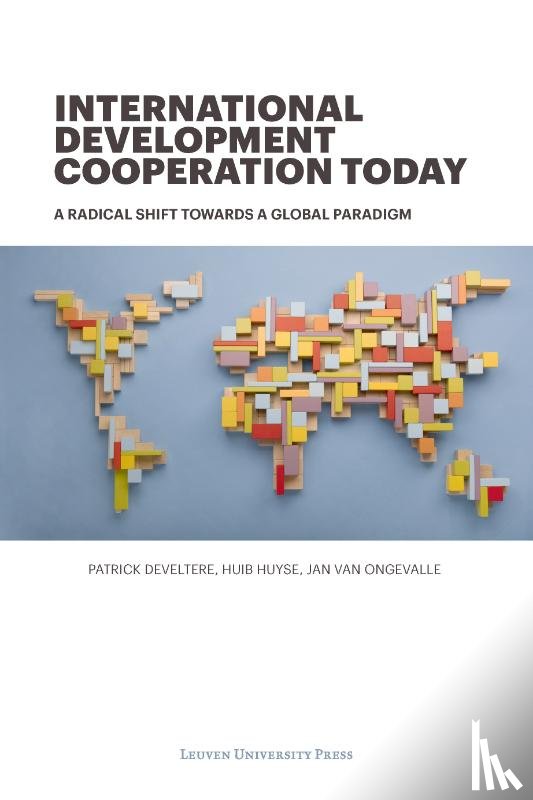Omschrijving
Beyond the traditional North-South perspective Over the past 60 years high-income countries have invested over 4000 billion euros in development aid. With varying degrees of success, these investments in low-income countries contributed to tackling structural problems such as access to water, health care, and education. Today, however, international development cooperation is no longer restricted to helping by giving. Instead, it is rather about opportunities, mutual interests, risk taking, and an inclusive societal approach. With the arrival of major new actors such as China, India, and Brazil, and the manifestation of private companies and foundations like the Bill and Melinda Gates Foundation, development aid is being eclipsed by new forms of international cooperation, increasingly accompanied by investments, trade, and give-and-take exchanges.
The agenda for sustainable development, adopted by all United Nations Member States in 2015 and to be realised by 2030, is a case in point of new influential frameworks that usher in a global rather than a traditional North-South perspective.
This book reviews 60 years of international development aid and its relevant actors, outlining today’s challenges and opportunities. Richly illustrated with case studies and examples, International Development Cooperation Today maps successes and failures and synthesizes visions and discussions from all over the world. By pointing out the radical shift from the traditional North-South perspective to a global paradigm, this book is essential reading for all practitioners, academics, and donors involved in development aid. Over the past 60 years high-income countries have invested over 4000 billion euros in development aid. With varying degrees of success, these investments in low-income countries contributed to tackling structural problems such as access to water, health care, and education. Today, however, international development cooperation is no longer restricted to helping by giving. Instead, it is rather about opportunities, mutual interests, risk taking, and an inclusive societal approach. With the arrival of major new actors such as China, India, and Brazil, and the manifestation of private companies and foundations like the Bill and Melinda Gates Foundation, development aid is being eclipsed by new forms of international cooperation, increasingly accompanied by investments, trade, and give-and-take exchanges.
The agenda for sustainable development, adopted by all United Nations Member States in 2015 and to be realised by 2030, is a case in point of new influential frameworks that usher in a global rather than a traditional North-South perspective.
This book reviews 60 years of international development aid and its relevant actors, outlining today’s challenges and opportunities. Richly illustrated with case studies and examples, International Development Cooperation Today maps successes and failures and synthesizes visions and discussions from all over the world. By pointing out the radical shift from the traditional North-South perspective to a global paradigm, this book is essential reading for all practitioners, academics, and donors involved in development aid. List of figures
List of tables
List of boxes
Abbreviations
Preface
Introduction
Development cooperation in an era of globalisation
More and more new actors on the scene: is the sector still a community?
Big donors, generous donors
More conflicting views and approaches: the arena is getting tough
More transactional interests: market appeal
Do new donors have other interests?
Everybody from payers to players: the emergence of a new paradigm
From colonialism to the Sustainable Development Goals
Colonial warm-up exercises
Technical cooperation and knowledge transfer
Faith in development aid
Development cooperation: aid in a global setting
The Washington Consensus and structural adjustments
International cooperation, the Millennium Development Goals and the Sustainable Development Goals
Addressing poverty in exchange for debt relief
International development cooperation and Paris: introducing order to the community and the market
The SDGs and the need for a whole-of-government and whole-of-society approach
It takes two to tango
Internationally: among specialists
Recipient countries: donor darlings and donor orphans
The first pillar: official bilateral cooperation
Many small players and institutional pluralism
In search of an institutional foundation for development cooperation
Decentralisation: to reach the SDGs or also for other reasons?
The second pillar: multilateral cooperation
Europe’s development cooperation patchwork
Multilateral cooperation: the UN galaxy fans out further
The third pillar: non-governmental development organisations
A movement with many faces, roles, visions and strategies
Several generations of NGDOs
A sector with many different visions and strategies
A movement with a plural support base
The sector breaks free from the NGDOs
Is the new social movement becoming an established network movement?
The fourth pillar: towards a whole-of-society approach
The key players of the fourth pillar
The fourth pillar: the children of globalisation challenge the children of the North-South
Starting from a different field
From a level ‘telling’ field to joint action
The near and distant future of a whole-of-society approach
Humanitarian aid: more dispersed or more networked?
What place for emergency aid?
Overcoming the humanitarian nemesis
Cash-and-carry on the market
The unbearable lightness of the support for development cooperation
The uneasy relationship with the support base
No (more) aid fatigue?
Popular, yet little understood
Something needs to be done: but by whom?
Time for a new narrative: from development education towards education for global citizenship
Sixty years of international development cooperation: where has the bumpy road led us? 261
Progress, but not for everyone
Is aid future-proof?
Are we really that generous?
Who is receiving aid?
The effectiveness and impact of development cooperation
Development cooperation: a stumbling-block?
Conclusion: the past will not come back but is still there
Notes
Bibliography


